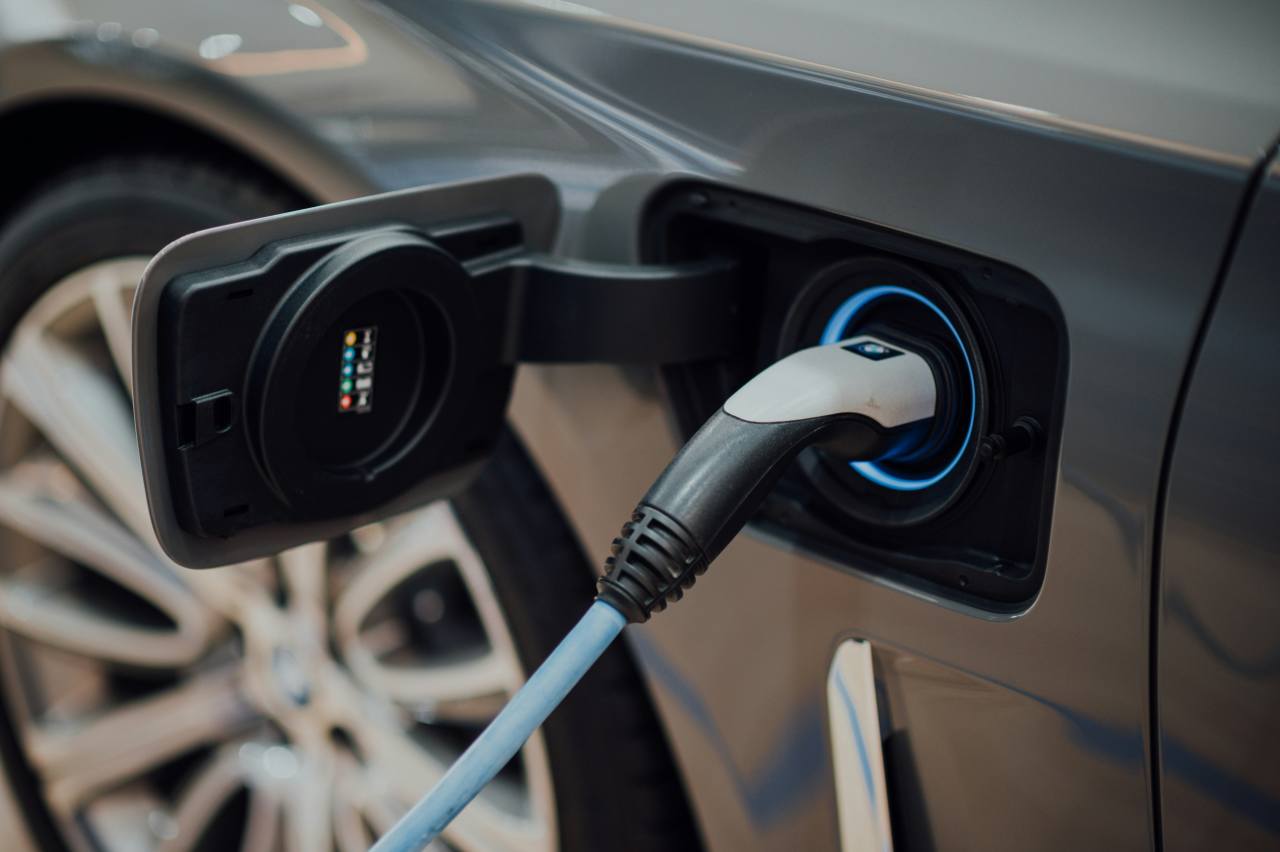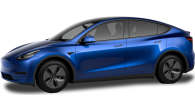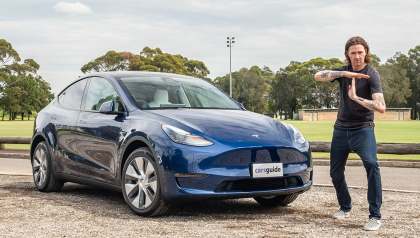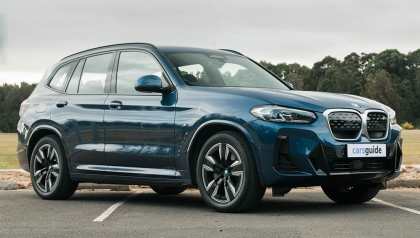What is it about single letters and performance cars?
BMW has M, Volkswagen has R, Lexus has F, and with only 23 choices left Hyundai opted for N - which stands for Namyang, site of the brand’s sprawling proving ground and development centre in South Korea, and Nurburgring, the famous German racing circuit where its performance cars are fine-tuned.
And like BMW M Sport, VW R-Line and Lexus F Sport, the Korean giant has N Line as a ‘lite’ option. Sporty models that add a little more punch and visual flair without crossing the line into hardcore hot-rod territory.
And this is one its latest examples, the pure-electric Ioniq 5 SUV in top-spec Epiq AWD trim and equipped with the N Line Option Pack as well as the tricky Digital Mirror Pack.
In this configuration it slots into the $90K price band, which means it has a lot to live up to in terms of performance, safety, driving dynamics, value and more.
So, stay with us to see if this premium five-seater is the kind of sporty EV SUV that gets your heart racing.
Hyundai Ioniq 5 2024: Epiq AWD (84Kwh)
| Engine Type | 0.0L |
|---|---|
| Fuel Type | Electric |
| Fuel Efficiency | 0.0L/100km (combined) |
| Seating | 5 |
| Price From | $83,270 - $95,700 |
| Safety Rating |
|
Price and features – Does it represent good value for the price? What features does it come with? 8/10
8 / 10
It shows how far the Hyundai brand has come over its close to 40 years in the Australian new-car market that one of its five-seat SUVs wearing a price tag in excess of $90K doesn’t knock the Earth off its axis.
But a sticker price of $91,300, before on-road costs, does apply the pressure because it puts this primo Ioniq 5 Epiq N Line AWD in the same orbit as versions of the Audi Q4 e-tron, BMW iX3, Mercedes-Benz EQB, Tesla Model Y and Volvo’s XC40 Recharge.
In fact, our test car’s price includes the N Line Pack which is technically a $2500 option and its digital mirrors add a further $3000 for an as-tested price of $94,300, before on-road costs.

So, you should rightfully expect a handsome standard equipment list and this full-fat Ioniq 5 doesn’t disappoint.
Aside from the safety and performance tech we’ll get to shortly this car includes 20-inch alloy rims, all LED exterior lights (with auto LED projection headlights), dual-zone climate control, power driver and front passenger seats (heated/ventilated), heated rear seats, ambient lighting, a head-up display, wireless Android Auto and Apple CarPlay, Bose eight-speaker audio, digital radio, built-in nav and voice control for key functions.

There’s also Alcantara- and leather-appointed seat trim, BlueLink connected car services (with a five-year complimentary subscription), configurable ambient lighting, wireless device charging, a fixed glass roof, a heated steering wheel, heated and power-folding exterior mirrors, auto rain-sensing wipers, keyless entry and start, and ‘Remote Smart Parking Assist’.

That last one allows you to start and move the car forwards and backwards remotely (via the key) to insert it into or extract it from tight parking spots… or just impress your friends.
Suffice it to say the Ioniq 5 Epic N Line AWD stands up well against its competitors when it comes to included features for the money.
Design – Is there anything interesting about its design? 8/10
8 / 10
Is this a big hatchback or a mid-size SUV? I’m on team hatchback, while Hyundai defines the Ioniq 5 as an SUV.
But who cares? They’re just words and the fact is even after close to three years in market this five-seater looks fresh and contemporary thanks to its confident, chiselled lines and wide stance.
For car-spotters the N Line exterior treatment consists of flat aluminium badging, specific bumpers front and rear, with a deeper nose spoiler incorporating larger vents to cool the front brakes.
There’s also body-coloured cladding and side skirts, gloss black mirror caps, unique 20-inch alloy rims and a ‘hidden’ lighting signature across the top of the front bumper.
Inside there are Alcantara- and leather-appointed seats, an N Line-exclusive partially-perforated leather steering wheel, red contrast stitching and accents, and brushed metal covers on the pedals.
Add in the twin 12.3-inch screens display and this understated, super-cool interior comes to life with a sporty twist.
The Ioniq 5 scores points for a manual dial for audio control and an Ioniq 5 update earlier this year included a row of simple-to-use buttons for the ventilation system and another on the centre console for seat comfort settings and more. A sensible blend of physical and digital controls.

Practicality – How practical is its space and tech inside? 8/10
8 / 10
At just over 4.6m long, a little under 1.9m wide and a fraction more than 1.6m tall the Ioniq 5 comfortably fits the medium SUV profile.
But arguably its most significant dimension is a 3.0m wheelbase which is huge for a car of this size as evidenced by the wheels pushed out to the corners.
What that means is plenty of space inside, but before you can even get in the capacitive touch power door handles may look cool and help aero performance with their flush fit design but I’m not a fan. They’re hard to grip most of the time and don’t work well from an ergonomic point-of-view.
That said, once inside the front seats are adjustable six ways to Sunday and at 183cm tall I have plenty of head space and breathing room in general.
In terms of storage there are big pockets in the doors with room for bottles and thanks to the ‘shift-by-wire’ gear controller located on the steering column there’s room between the seats for a substantial console including a pair of cupholders, a slot for devices and a lidded tray (which doubles as a centre armrest) with that whole rear section able to swing up to allow access to a large lower shelf underneath.
In fact, the entire console unit easily slides fore and aft to liberate more legroom for the centre rear position. There’s also an oddments cubby in the lower part of the dash and a decent glove box.
Then, for connectivity and power there are three USB-C sockets (one in the dash switchable to streaming), a wireless device charging pad and a 12-volt outlet.
In the back that long wheelbase comes into its own. Sitting behind the driver’s seat set for my position I have loads of foot, leg and headroom.
Storage runs to door pockets with room for bottles, a fold-down centre armrest with a pair of cupholders, there are netted map pockets on the front seat backs and pull-up sun shades on the rear windows.
There are controls for the front passenger seat on the inner edge of the front passenger seat backrest which allows rear seaters to adjust its position. Thoughtful.
For power there’s a pair of USB-C sockets and individual ventilation controls in the back of the B-pillars is welcome.
Then, not only is the electrically-adjustable rear seat split 60/40 in the backrest, it’s in the cushion, as well, which adds extra flexibility in terms of a balance between rear passenger space and room in the boot.
The boot is generous at 527 litres (VDA) with the rear seat upright and 1587L when it’s folded down.
There’s also a handy 24L ‘frunk’ under the bonnet, a decent portion of which is devoted to the (included) charging cable.
Interestingly, the Ioniq 5 AWD is rated to tow a 1600kg braked trailer with a trailer pre-wiring package standard.
There’s a repair/inflator rather than a spare tyre, which is never a good thing, but there is a ‘smart’ power tailgate and a ‘Vehicle-to-Load’ function that allows you to power and/or charge three-pin appliances from the car. Handy.
Under the bonnet – What are the key stats for its engine and transmission? 8/10
8 / 10
The Ioniq 5 Epiq AWD is powered by a permanent magnet synchronous electric motor on each axle, both powerful, but the rear unit packs a bigger punch.
And combined peak outputs of 239kW and 605Nm are substantial with especially the latter delivering eye-widening acceleration.
Drive goes to all four wheels via a single-speed, reduction gear auto transmission on both axles. And a ‘Disconnector Actuator System’ is able to disengage the front wheels to reduce drag losses from the front motor and improve energy efficiency.
Efficiency – What is its fuel consumption? What is its driving range? 8/10
8 / 10
The Ioniq 5 Epiq AWD is powered by an 84kWh liquid-cooled lithium-ion battery, borrowed from the high-performance Ioniq 5 N.
Thanks to 800-volt compatibility it can accept a 350kW DC charge which translates to an up to 80 per cent charge time of around 18 minutes, which expands to just over an hour using a more typical 50kW charger.
Connect to AC at the Ioniq 5’s maximum 10.5kW capacity and quoted charge time is just over six hours.
Official energy consumption on the combined (urban/extra-urban) cycle is 19kWh/100km and claimed range is a useful 495km.
Over a mix of urban, suburban and freeway running on test we saw a real-world average of 16.8kWh/100km, which is impressive for a car with this much performance potential.
Driving – What's it like to drive? 9/10
9 / 10
In terms of straight line performance we’re talking 0-100km/h in a tick over 5.0 seconds and I see anything in the five-second bracket as properly quick.
With more than 600Nm of peak pulling power at your disposal there’s always plenty of pulling power for efficient in-traffic moves and safe highway overtaking.
The shift-by-wire gear selector on the steering column takes some getting used to but once you’re in tune with it, it’s surprisingly convenient, especially during slow speed parking or turning manoeuvres.
There are multiple modes - ‘Eco’, ‘Normal’, ‘Sport’ and ‘Snow’. Sport mode spices things up a bit with more urgent responses and the ‘HTrac’ AWD system uses multiple sensors to manage potential wheelspin and optimise drive in wet conditions or on loose dirt surfaces.

Suspension is by struts at the front and multi-links and the rear and the Ioniq 5 in this configuration is ultra-smooth and comfortable.
Even hitting pretty aggressive speed bumps and ruts in the road and the car soaks them up without fuss. You’re used to EVs being a little harsh in terms of ride compliance thanks to their relative weight, but that’s not the case here.
As part of a model upgrade introduced earlier this year Hyundai says it undertook a “comprehensive revision to the suspension tune”, which includes high-performance dampers on this N Line. And despite low-ish profile (255/45) Michelin Pilot Sport EV tyres on the 20-inch rims it remains comfortable and quiet.
The upgrade also included body reinforcements in the B- and C-pillar, door surrounds and under the body for a stiffer platform overall.

That pays off in the dynamics. Despite its 2.1-tonne weight the Ioniq 5’s steering is accurate and nicely weighted. It doesn’t feel lumbering or ponderous despite its relative heft.
The physical brakes are ventilated discs front and rear with regenerative available through four levels, the most aggressive setting being ‘i-Pedal’ which allows single-pedal driving.
It will slow the car to a full stop, harvesting the most energy possible in the process, although you might need a dab on the brake pedal if things are tight.
Miscellaneous observations include a 12m turning circle, so be ready for three-point turns where you didn’t think you’d have to.

Hyundai's (and Kia’s) default over-speed warning is present in full-force taking clicks through multiple screens to switch off and avoid its incessant audible alarm saying you've exceed what the car believes is the posted limit (every time you restart the car).
The recently released Tucson Hybrid features a short-cut function to do away with this issue and it would be welcome here.
The CPU underpinning the multimedia system is more powerful and response is speedy without a hint of lag.
And the camera based ‘mirrors’ take some getting used to. For many, they’re the answer to a question no one was asking. I mean, conventional mirrors work pretty well and any aero benefit from the smaller camera units has to be modest. But once you’re in tune with them the hi-def screens are excellent.
A flip of the switch on the interior rear view mirror allows you to side-step tall heads or loads in the back of the car but minimal depth of field is also (visually) awkward at first.
Warranty & Safety Rating
Safety – What safety equipment is fitted? What is its safety rating 9/10
9 / 10
The Ioniq 5 received a maximum five-star ANCAP score from assessment in 2021, receiving its highest scores for adult and child occupant protection and the on-board safety assist systems.
The Ioniq 5 stacks up well relative to its competitors when it comes to safety. In fact, there’s so much crash avoidance tech on-board, courtesy of the Hyundai ‘SmartSense’ active safety suite, it would be straight up boring to list it all, but the highlights include AEB (with car-to-car, pedestrian and cyclist detection as well as junction turning and crossing functions), blind-spot monitoring and collision avoidance, lane keeping assist and lane departure warning, rear cross-traffic alert and rear AEB as well as active cruise control (with stop and go).

There are even more assists, warnings, monitors and alerts, but it’s important to note they (almost) all operate with relative subtlety. I did switch off the steering assist/lane-keeping functionality when it became confused and overly intrusive on twisting city curves.
If a crash is unavoidable, there are seven airbags on-board including a front centre bag to minimise head clash injuries in a side-on impact, as well as ‘Automatic Collision Notification’ and an emergency SOS call function operated through the Bluelink system.
For baby capsules/child seats there are three top tether points across the second row with ISOFIX anchors in the outer positions.
Ownership – What warranty is offered? What are its service intervals? What are its running costs? 7/10
7 / 10
Hyundai covers the Ioniq 5 with a five-year/unlimited-km warranty, which is the mainstream market norm, with a separate eight-year/160,000km warranty for the drive battery; also an expected term.
Roadside assistance and sat-nav updates are renewed annually if the vehicle is serviced at an authorised Hyundai dealer.
Service interval is two years/30,000km which is appropriate for an EV given its relative mechanical simplicity and a ‘Lifetime Service Plan’ locks in scheduled maintenance costs for the life of the vehicle.
Service cost for the first five years is $1220, with each of the two services required in that time coming in at $610. Competitive for an EV in this part of the market.
Verdict
The Hyundai Ioniq 5 Epiq N-Line AWD leverages an electric powertrain’s best attributes brilliantly well.
It’s ultra smooth and comfortable with ample performance and great dynamics thanks in part to this car’s N Line spec.
Its price tag pits it against formidable competition from the German Big Three, Tesla and others. But it has what it takes in terms of quality and value to fight that battle. It’s an impressive machine.
Pricing Guides
































.jpg)

